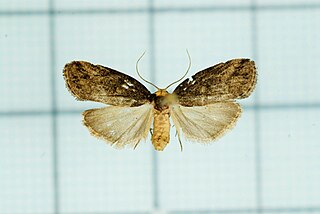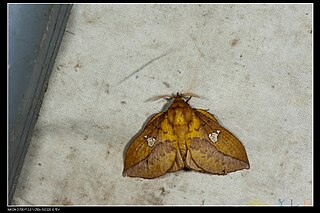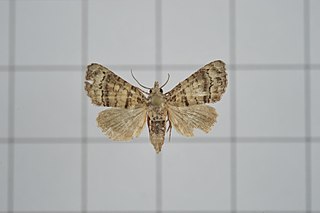
Eugoa is a genus in the family Erebidae, subfamily Arctiinae. The genus was erected by Francis Walker in 1858. They are found in India, Sri Lanka, Myanmar and Borneo.

Carmara is a monotypic moth genus of the family Noctuidae. Its only species, Carmara subcervina, is found in Sri Lanka, Japan, Taiwan, Borneo and Australia. Both the genus and species were first described by Francis Walker in 1864.

Rivula is a genus of moths in the family Erebidae described by Achille Guenée in 1845.

Homona coffearia, the tea tortrix or camellia tortrix, is a moth of the family Tortricidae. The species was first described by Nietner in 1861. It is widely distributed in the Oriental region.

Scirpophaga incertulas, the yellow stem borer or rice yellow stem borer, is a species of moth of the family Crambidae. It was described by Francis Walker in 1863. It is found in Afghanistan, Nepal, north-eastern India, Sri Lanka, Bangladesh, Myanmar, Vietnam, Thailand, Malaysia, Singapore, Sumatra, Java, Borneo, Sumba, Sulawesi, the Philippines, Taiwan, China and Japan.
Acleris extensana is a species of moth of the family Tortricidae first described by Francis Walker in 1863. It is found in Sri Lanka, India, China and Vietnam.

Euthrix laeta is a moth of the family Lasiocampidae first described by Francis Walker in 1855.

Bamra albicola is a moth of the family Noctuidae first described by Francis Walker in 1858.
Hyperlopha cristifera is a moth of the family Noctuidae first described by Francis Walker in 1863. It is found in Sri Lanka, Laos, Malaysia and Australia. Adult wings are pale brown, sometimes with a number of dark dots near the tornus of each forewing. Forewings with a hooked wingtip, and a cusp on the margin can be found.

Timandra comptaria is a moth of the family Geometridae first described by Francis Walker in 1862. It is found in Sri Lanka, Japan and Taiwan.

Phazaca erosioides is a moth of the family Uraniidae first described by Francis Walker in 1863. It is found in the Indo-Australian tropics from Sri Lanka to New Guinea.

Avitta quadrilinea is a moth of the family Noctuidae first described by Francis Walker in 1863. It is found in Borneo, Peninsular Malaysia, Thailand, the Indian subregion, the Philippines, Sulawesi and Sri Lanka.

Chlumetia transversa, the mango shoot borer, is a moth of the family Euteliidae. The species was first described by Francis Walker in 1863. It is a widely distributed across Indo-Australian tropical countries far east to Solomon Islands.
Eutelia approximata is a moth of the family Noctuidae first described by Francis Walker in 1863. It is found in Sri Lanka and Sundaland.
Leucania roseilinea, the grain army worm, is a moth of the family Noctuidae. The species was first described by Francis Walker in 1862. It is found in Sri Lanka, Myanmar, Sundaland, the Philippines to New Guinea.
Arrade erebusalis is a moth of the family Erebidae first described by Francis Walker in 1863. It is found in Sri Lanka, Nicobar Islands, Singapore, Borneo, New Guinea, Bismarck Islands and Australia.
Rivula albistriga is a moth of the family Erebidae first described by George Hampson in 1893. It is found in Sri Lanka.

Rivula basalis is a moth of the family Erebidae first described by George Hampson in 1891. It is found in South India, Sri Lanka, Indo-China, Thailand, South China, Taiwan, Java, Bali and Borneo.
Rivula bioculalis is a moth of the family Erebidae first described by Frederic Moore in 1877. It is found in Sri Lanka, the Andaman Islands, the Indian subregion, Taiwan, Thailand and Borneo.
Hypena mandatalis, is a moth of the family Erebidae first described by Francis Walker in 1859. It is found in the Indian subregion, Pakistan, Sri Lanka, Borneo, Sulawesi and Australia.












